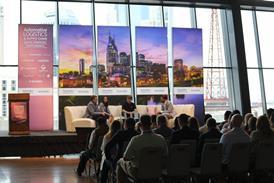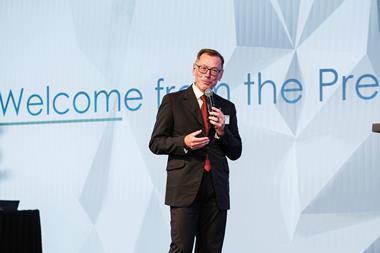The 16th Automotive Logistics Global conference, at the Detroit Marriott Renaissance Center, brought together an industry growing and with positive outlooks. However, the potential changes heralded by the digital economy could upend business as usual. The question is when?

Click below for more headlines and stories from Automotive Logistics Global in Detroit (more stories will be added in the coming day)
- Disruption is key to the future
- Time to pack in the waste
- Good signs for cross-border flows
- Joining the dots on innovation
- Reducing waste in FVL
- The challenges and opportunities of short-sea in Mexico
- The difficulties of innovating within FVL
- Supply chain providers need to get data savvy to survive
- Panel discussion: Where is the industry heading?
Some of that volume would come from Mexico both in increased volume moved by rail, as well as new exports moving by short sea. However, there are still uncertainties about Mexico’s infrastructure and ability to cope with this increase. For example, the country’s largest port for moving finished vehicles, Veracruz on the Gulf Coast, lacks a dedicated car terminal and has issues over draughts for handling larger ships. According to Roberto Zavala, head of Mexico for WWL, current government plans for investment at Veracruz don’t include finishing a new ro-ro terminal until well into the next decade – and perhaps not before 2030.
“That is ridiculous, because we are seeing the boom in vehicle exports now, and can’t wait until 2030,” he said.
On the inbound side, a restructuring is occurring across the component supplier industry. While there has not been much consolidation among carmakers – and Mason doesn’t expect much over the next decade despite the overtures of Sergio Marchionne, chief executive officer at Fiat Chrysler Automobiles (FCA), to bring together his company with General Motors – there has been a record amount of activity in mergers and acquisitions across tier suppliers. PwC is forecasting that 2015 will finish with a record $48 billion in closed transactions among tier suppliers, up from $14 billion last year. Notably, the value of those transactions are across fewer deals – around 200 – compared to past years; in 2011, for example, there were over 300 deals worth just $10 billion. The large amounts demonstrate the consolidation among big companies, of which ZF’s takeover of TRW is perhaps the most notable, as well as the rising value of component suppliers.
“We expect more supplier consolidation. If you were thinking about selling, now seems to be a good time,” he said.
The revolution will be digitised
Supplier consolidation raises several points for the automotive logistics industry. A consolidated industry will change aspects of how logistics is managed and procured across tier suppliers, for example. However, perhaps even more fundamentally, many of the transactions among tier suppliers have been based around gaining technology involved in driver automation features, and herald the continuing rise of what is being referred to as ‘Digital Business’ for the automotive industry.
Digital business refers broadly to areas including autonomous vehicles, ‘connected equipment’, such as machine-to-machine technology, wearables like smartwatches and glasses, advanced levels of automation, such as ‘smart robots’, and analytics or ‘big data’. Much of this technology could transform the economy – including automotive logistics, especially in areas like truck driving, parts handling and warehousing, IT or freight brokerage.
 IBM Analytic's Kalman Gyimesi said that telematics suppliers had big ideas about optimising downstream automotive logistics
IBM Analytic's Kalman Gyimesi said that telematics suppliers had big ideas about optimising downstream automotive logisticsMany executives at the conference agreed such changes and technology were coming to the industry, although some had different ideas about the timings of their adoption and their impact in the supply chain. Kalman Gyimesi, automotive marketing leader for IBM Analytics, cited a survey of supply chain executives in which 75% said they expect disruption over the coming decade from new mobility, telematics and other internet-related technologies.
“So far we have not seen much impact, but technology providers are looking at the sector. Companies that are now brokering new vehicle sales have big ideas about the downstream movement of vehicles and how to optimise that, for example,” he said.
Scott Dewicki, leadership partner at Gartner, also pointed to radical changes that would impact the supply chain. “We are already seeing how telematics connects consumers with OEMs to improve vehicle maintenance and the service life cycle; predicts insurance risk; and even alerts first responders in the event of a vehicle accident,” he said. “But those are about the product and the consumer – the automotive supply chain is about to get a front row seat to the digital business revolution.”
Bradley Jacobs, the chairman and chief executive officer of XPO Logistics, which is in the process of completing an acquisition of Con-way Logistics followings its takeover earlier this year of Norbert Dentressangle in Europe, said that he expected major disruption across the logistics and automotive space. He referenced an executive from a major freight brokerage in North America who last year said that he didn't fear being put out of business by an app because it wouldn’t be able to handle all of the intricacies of logistics.
“Well, I do fear being put out of business by an app. I think Google has a chance to disrupt OEMs, 3PLs, 4PLs and all the carriers,” he said. “Everything that we’re doing right now has a strong possibility to be disrupted.”
Some of the change has the potential to be positive and reduce costs. Driverless trucks, for example, would help relieve driver shortages and take labour out of the supply chain. But they could also eliminate jobs and even entire companies if they don’t keep up with change, warned Jacobs. He is expecting further consolidation among logistics providers mainly as a means to reduce excess cost, which will then need to be re-invested in research and development.
 XPO Logistics' CEO Bradley Jacobs anticipated more consolidation in the logistics industry
XPO Logistics' CEO Bradley Jacobs anticipated more consolidation in the logistics industry“We have about $14 billion in costs every year, and by coming together and gaining greater scale we can take out a few million dollars in inefficiencies and in areas like back office, administration, etc.,” he said. “We want to take those savings and dedicate them to R&D – so do projects in IT, and be connected to customers and ask what they want.”
Matthias Schulz, who become the director of North American material planning and logistics at Ford after leading operations in Europe, also said that automotive logistics would see dramatic change. He pointed to the example of the mobile phone industry, where companies that had been dominant just a decade ago, like Nokia, don’t exist anymore. “And as I think about things like Uber, I’m sure it is not a question of if but when something significant will also change logistics. I don’t know exactly what it is or when it will happen, but it is coming,” he said.
Evolution or revolution?
The conference offered some examples of ‘smart’ technology that is already starting to appear in automotive logistics. Volker Vossler, vice-president of operations for the Mexico region at Seglo Logistics, a division of Germany’s Schnellecke Group, revealed that the company has started trialling the use of drones to carry out ‘cycle counts’ of inventory in its warehouses. Whereas currently workers need to be raised on forklifts to check inventory, the drones can move around the warehouse at any height to record or scan items. Vossler said that such an approach could save “huge” amounts of time, improve flexibility and safety.
The company is also trialling ‘pick-by-vision’ headsets that employ Google Glass technology. On top of that, it is using virtual reality environments to train its staff to help improve performance and safety.
Vossler acknowledged that some of this technology, such as the warehouse drones, could lead to job losses. “It is normal for there to be some violence in revolutions,” he said.
However, such applications are still relatively rare for automotive logistics, an industry that is self-avowedly risk averse and more ‘evolutionary’ than revolutionary. Gartner’s Dewicki suggested that much of the talk around these new technologies in logistics was still “mainly hype”.
“Many of the truly autonomous systems and related capabilities are at least 3-5 years off, and often more, from being robust enough to bet the farm on them,” he said. “Nevertheless, there are plenty of capabilities that have real world benefit right now. What remains is to figure out how to use them to reinvent our supply chain practices.”
Other executives suggested that the digital revolution might remain more of an ‘evolution’ for automotive. PwC does not foresee any major disruption to vehicle sales or assembly within its forecast horizon, and Brandon Mason suggested there might not be major impacts for 20 years. “I’m not being a naysayer or denying the importance of technology like driverless cars, but I think there are a lot of things to work out, including from a cyber security point of view and otherwise,” he said.
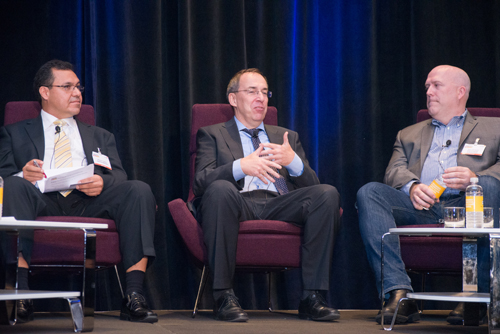 Ford's Matthias Schulz (centre) suggested 'Uber-like' disruption would come to automotive logistics
Ford's Matthias Schulz (centre) suggested 'Uber-like' disruption would come to automotive logisticsThere are also questions over the extent to which automotive logistics will change in a more ‘connected’ future. Marc Brazeau, head of NAFTA vehicle transportation for Fiat Chrysler Automobiles (FCA), suggested that, at least for the outbound chain, a connected, self-propelling car might not radically change the dynamics and challenges of vehicle distribution.
“As a driver there are a lot of things that will change. But for the tactical supply chain, I think it’ll be the same things that we’re doing, at least in the near future,” he said.
Paul Biegen, director of global logistics and customs at tier supplier Key Safety Systems, said that drones, driverless trucks and 3D printers might well disrupt logistics in the coming years or decades. But he also admitted that they weren’t such a concern to him in his current supply chain. “I’m not that concerned about them in day-to-day operations. Innovations need to add value,” he said. “I’m more interested in going from 500 pieces in a box to 900 – it might not seem it, but that is a perfect example at my company of innovation.”
Ed Feitzinger, chief executive officer at UTi Worldwide, also pointed out that while western Europe and the US might be moving towards driverless trucks and drones, the dynamics were different in other global markets. “If you’re in India you just want a truck that goes from A to B. If you’re a Chinese OEM trying to penetrate east Africa, you want to cross a border,” he says. “We’re trying to grow ‘first world’ transport in places where customers are trying to expand. In these places, we’ll leave the drones until afterwards.”
Other executives suggested that the real change would come to the way cars are sold and used, including through more online car purchases as well as ‘pay-by-use’ approaches rather than ownership – all of which is likely to impact logistics. “The younger generation doesn't want to own a car, they want to use a car. We need to adapt to that,” said Ford’s Matthias Schulz.
Miguel Tavera, director of global logistics purchasing at General Motors, predicted that customers would shift away from purchasing cars via dealers to buying online. “We’re going to need a manufacturing and logistics processes that is much more flexible and responsive,” he said. However, he also didn’t foresee that this shift would radically alter automotive logistics.
 Seglo Logistics' Volker Vossler revealed how the company was trialling drone and Google Glass technology in its operations
Seglo Logistics' Volker Vossler revealed how the company was trialling drone and Google Glass technology in its operationsDoes automotive logistics need a wake up call?
Ultimately, the conference did not forecast the death knell of the automotive logistics industry. Continued strong growth will continue to propel the industry towards more traditional services and investment, whether by multimodal transport modes, cross-border flows with Mexico, or improved packaging. Executives are focused on continuous improvement and cost savings strategies. Brad Jacobs maintained that, regardless of the technology used, logistics providers would have to continue offering carmakers the best possible service at the cheapest possible price.
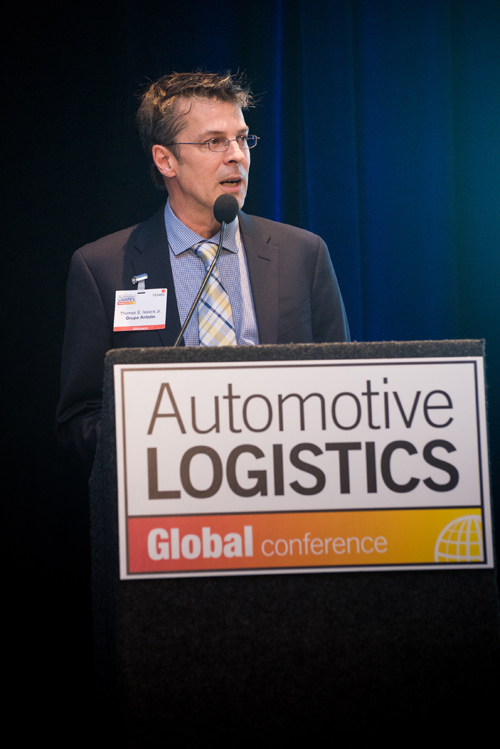 Thomas Isaacs from Grupo Antolin said that data mining could help tell a story to improve operations – if the data was properly understood
Thomas Isaacs from Grupo Antolin said that data mining could help tell a story to improve operations – if the data was properly understood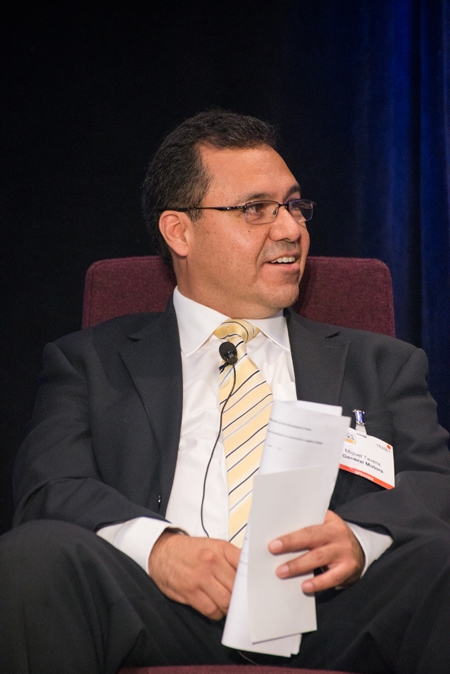 Miguel Tavera said that GM is looking at how logistics works across industries, including at Amazon
Miguel Tavera said that GM is looking at how logistics works across industries, including at Amazon“We still tend to hear about improvement, not innovation. It’s not finding new ways to do the same old things. Cutting costs is not innovation,” he said. “If you are not innovative you won’t be part of the modern economy. That should be a wake up call.”
Logistics executives at the conference certainly did not want to come across as naysayers or luddites in the face of changing technology. Even if some questioned whether everything would change drastically, most still emphasised the need to adapt to the changing needs of consumers. GM’s Miguel Tavera said that he speaks often with his logistics providers about taking in ideas from other industries and companies, such as Amazon.
“We do need to reach out and understand how do we cope with those changes that are happening so fast. We’re focusing on that at GM, breaching out across various sectors to understand them better,” he said. “However, in many cases automotive is still considered among the most advanced and unique for logistics.”
Regardless of the next step in the evolution, or indeed revolution, an openness to change will surely be important criteria across the automotive logistics sector. Gartner’s Scott Dewicki pointed out that one of the major things that could hold back the application of wearables and connected technology in the short term would be executives who were unwilling to change.
However, he pointed to one study that suggested this problem might be “self correcting” – perhaps 50% of those managers would either turnover or see their own jobs disappear in the coming years. Some executives may not even have time to see what’s coming ahead of them.
The next conference in the Automotive Logistics series of events will be Automotive Logistics Brazil in São Paulo, on November 3rd.
The next conference to take place in North America will be Automotive Logistics Mexico in Mexico City the end of January.


























